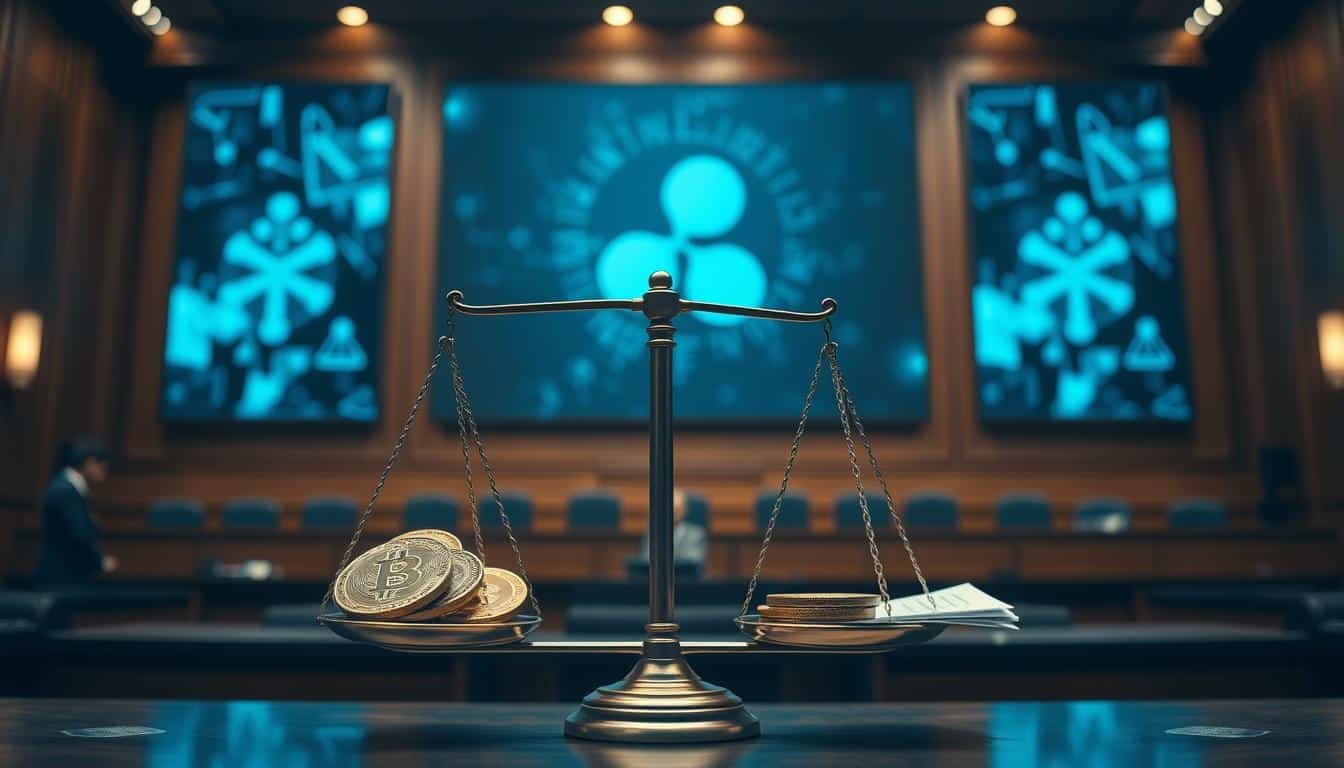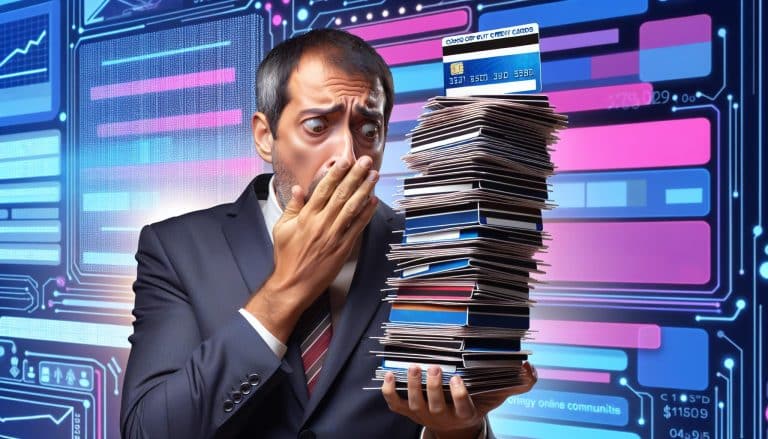Ripple vs SEC News: Latest Updates on Legal Battle
Did you know Ripple Labs was ordered to pay the SEC a $125 million fine? This amount is far less than the $2 billion penalty the regulators initially wanted1. Ripple’s CEO, Brad Garlinghouse, sees this as a win for both Ripple and the crypto world2.
Though Ripple hoped to keep the fine to $10 million, the court settled on $125 million1. This legal struggle has drawn attention from many, causing a 26% jump in XRP’s price after the decision1. Keep an eye on us for the latest on this intense legal fight.
Key Takeaways
- Ripple faces a $125 million fine, much lower than the SEC’s initial $2 billion demand.
- XRP saw a significant price increase of 26% following the ruling.
- Ripple’s CEO hailed the court’s decision as a victory for the crypto industry.
- Ripple attempted to limit the fine to $10 million but was unsuccessful.
- Ripple plans to promptly pay the penalty from its balance sheet and move forward12.
Background on the Ripple vs SEC Lawsuit
The lawsuit between Ripple and the SEC has been in the spotlight since December 2020. It started when the SEC claimed Ripple raised over $1.3 billion through an unregistered security offering of XRP3. This case is a key event in the world of cryptocurrency, with both sides presenting strong arguments.
The Initial Complaint by the SEC
The SEC accused Ripple of selling XRP as unregistered securities. They argued that XRP fits the definition of a security, changing how cryptocurrencies are regulated. The SEC wants heavy fines from Ripple, citing violations of securities laws4. They are even ready to appeal the case to ensure enforcement3.
Ripple’s Defense and Counterarguments
Ripple is defending itself by stating XRP is a commodity, not a security. They believe XRP’s use and decentralized nature doesn’t match the Howey test’s criteria for securities. Their main defense points to how XRP is different from traditional securities. Ripple is also questioning the SEC’s regulatory interpretations, hoping to change crypto regulation in the U.S5.
Key Court Rulings and Decisions
The fight between Ripple and the SEC had major court rulings.
Partial Victory for Ripple in 2025
In 2025, Ripple won an important battle. The U.S. District Court in New York decided that XRP isn’t an investment contract. This meant it wasn’t considered a security6. This was great news for Ripple. Instead of facing a $2 billion fine, they were only fined $125,035,1507.
Implications of the District Court’s Findings
The Court’s decision changes how sec regulations on cryptocurrencies are applied. It made a clear line between different types of XRP sales7. Ripple’s big sales might get more attention from regulators, but other sales won’t7. After this decision, XRP’s value and sales went up, showing the market liked the news6.
Details of the $125 Million Fine
Ripple Labs must now pay a civil penalty of just over $125 million. This comes after a long legal fight. The SEC originally wanted close to $2 billion8.
The court found 1,278 transactions broke the securities laws8. This major cut in the fine shows Ripple had a good outcome.
Breakdown of the Penalty Calculation
The fine covers 1,278 contracts Ripple made, breaking the law9. At first, the SEC wanted Ripple to give up more than $876 million in profits. They also wanted $198 million in interest and another $876 million fine, all rejected by the court9.
Now, Ripple has 30 days to pay the $125 million fine8.
Ripple’s Response to the Fine
Ripple sees the fine as a win, despite the challenge8. They faced a huge potential penalty of nearly $2 billion from the SEC9.
Now, with just a $125 million fine, they’re moving forward more optimistically. This has led to a positive look at ripple price analysis.
XRP Price Reactions to Legal Developments
Recent legal events have had a big impact on XRP prices. This is part of the ongoing story between Ripple and the SEC. XRP and the wider crypto market’s ups and downs often tie back to court decisions.
Immediate Market Impact Post-Ruling
After Judge Analisa Torres’ decision in July 2025, XRP’s value went up a lot. On July 22, it increased by 1.76%, closing at $0.6084. During the same time, the rest of the crypto market went down by 1.69%, making the total market worth $2.387 trillion10. XRP’s quick rise shows that investors are hopeful. They believe in Ripple’s ability to overcome legal obstacles.
Long-Term Price Trends of XRP
Looking at the bigger picture, XRP’s growth is clear. It stays above key averages, pointing to more gains ahead10. A specific pattern suggests a big price jump may be coming. This is similar to what happened in 2017, when XRP’s price soared by 61,150.10% in 337 days11.
Also, the market seems really interested in XRP. If it passes the $0.6609 mark, it might reach $0.7 next10. Experts think good court news could push XRP over $0.5. But, bad news from the SEC could lower its price to $0.311. The current trading data also points to big changes in price soon. This shows how quick and unpredictable the crypto market can be.
Institutional Sales: The Core Issue
The battle in the Ripple vs SEC lawsuit is about the institutional sales of XRP. The SEC argues these were unregistered security sales. This has sparked intense legal battles and numerous court decisions.
SEC’s Allegations on Institutional Sales
The SEC accused Ripple of selling XRP to big buyers without registering them as securities. According to the SEC, these sales were investment contracts under the Howey test. They wanted Ripple to pay over a billion dollars in fines and penalties12.
The court decided that Ripple’s direct sales to institutions did break the law. But, sales on exchanges did not count as investment contracts13. This ruling could change how digital currencies are regulated.
Ripple’s Counter to Institutional Sales Charges
Ripple fought back by saying their sales contracts to institutions were specific. They said these did not trick buyers. Ripple also stressed the difference in their sales on exchanges, which were not seen as investment contracts1213.
They also argued that giving XRP to employees or for partnerships was not the same as selling them. This argument helped Ripple to lower their fine to $125 million, much less than what the SEC originally wanted12.
Since the SEC’s lawsuit in 2020, Ripple sold $14 billion of XRP to big investors. They used $10.9 billion to buy back XRP on exchanges12. This strategy shows how important the court’s views are for crypto rules.
Ripple’s counterarguments did not just tackle the SEC’s claims. They also showed the challenge in fitting cryptocurrency transactions into current laws.
Ripple vs SEC News: Impact on Crypto Industry
The fight between Ripple and the SEC has shaken up the crypto world. It influences how people see and react to the market. Not just Ripple, but the entire digital asset space feels the effects of this battle.
Market Reactions and Sentiments
The SEC asked for a $2 billion fine, but Ripple only has to pay $125 million14. After the decision from Judge Analisa Torres, XRP’s value jumped over 20%14. This shows how legal decisions can quickly change the crypto market.
Ripple sees the fine as something they can handle. They pointed out the case made no fraud or manipulation claims15. Right now, XRP is worth $35 billion, showing investors still trust in it amid legal issues14.
Legal Precedents Set by the Case
This case is very important for the crypto world. It draws a line between institutional and retail sales of XRP16. This decision will affect how other cryptocurrencies are seen by regulators.
Ripple’s solution for liquidity now faces rules from the court. They can’t sell XRP as they did before without calling it a security16. This verdict clarifies the difference between types of sales. It guides other crypto projects on how to deal with the SEC.
| Impact | Detail |
|---|---|
| Ripple Fine | $125 Million—significantly lower than the $2 billion sought by the SEC16 |
| XRP Price Reaction | Surged more than 20% post-ruling14 |
| Market Cap | $35 Billion14 |
| ODL Solution | Affected by the court injunction16 |
| Institutional Sales | Deemed securities16 |
The appeals might go until 2025 or even 2026 before the Supreme Court decides14. The outcomes here will keep influencing how digital assets are regulated. Everyone is watching what this means for future legal issues in the crypto space. This situation will shape the rules for cryptocurrencies15.
Role of Brad Garlinghouse and Chris Larsen
Brad Garlinghouse and Chris Larsen are key players in the SEC lawsuit against Ripple. They are at the forefront, defending against claims of security violations. Their leadership shapes the direction of Ripple’s legal fight.
Charges Against Ripple Leadership
The SEC accused Brad Garlinghouse and Chris Larsen of helping Ripple violate regulations through XRP sales. Their roles in the crypto community made these charges widely noticed. Discussions often focus on their strategies in facing the lawsuit.
Dropped Allegations and Future Implications
The SEC unexpectedly dropped civil charges against Brad Garlinghouse and Chris Larsen in New York17. This move is a turning point in the legal battle, indicating a change in how crypto executives might face regulations. It sheds light on the SEC’s changing approach.
This event could influence the wider crypto regulation environment17. It may affect how other crypto companies handle legal and compliance issues.
SEC’s Arguments and Ongoing Demands
The SEC keeps pushing in the Ripple case, asking for full compliance after the final decision. They want Ripple’s financial details for 2022 and 2025 and agreements on institutional sales after December 202018. These requests aim to check for any violations after the lawsuit was filed.
Additionally, the SEC wants Ripple to return $2 billion19. This is far more than Ripple’s suggested penalty of under $10 million19. The difference shows the big gap in what each side thinks is fair. The SEC plans to file their remedies report by March 13, 202518, showing the pressing nature of their requests.
Ripple has spent over $150 million on its defense so far18. Even though Ripple had a partial win in court, the SEC still has issues with its institutional sales. The SEC argues these sales were unregistered securities18, hence continuing their strict oversight.
The SEC also wants permanent orders to stop Ripple from future violations19. This long legal fight, over three years now19, is a key moment for the crypto world. Both sides remain unmoved by the other’s stance.
| Key Event | Date | Detail |
|---|---|---|
| Court ruling acceptance of remedies-related discovery | Nov, 2025 | Accepted until Feb. 12, 2025 |
| SEC’s remedies brief filing | March 13, 2025 | Due date for SEC’s submission |
| Ongoing cost of Ripple’s defense | Updated | Over $150 million spent |
Ripple’s Global Business Strategy
Ripple has been expanding worldwide, avoiding strict U.S. laws. This growth is seen in its efforts to enter new markets and use different rules.
Expansion Outside the United States
Ripple hasn’t slowed down because of its legal issues. It’s making moves to grow globally. Reports suggest XRP might be used by the United Arab Emirates for oil deals20.
The BRICS countries are also working on a new payment system that uses crypto and blockchain. This is a big step for global finance20. Ripple is quick to find and use opportunities abroad.
Adapting to Regulatory Environments
Ripple works hard to meet different countries’ rules. It has smartly dealt with legal challenges and regulations. For example, Ripple had to pay a $125 million fine, much less than the $2 billion the SEC wanted20. This shows Ripple can handle pressure and find good solutions.
Ripple’s big plan is to shape the future of global finance. It wants to be a top choice in the $174.2 trillion B2B payment market by 203020.
This strategy helps Ripple stay strong against legal issues and keep up in the changing crypto world.
Find out more about Ripple’s latest strategic moves and their impact on the market here: Ripple’s Strategic Adaptations Amid Legal Challenges.
Next Steps in the Legal Battle
The legal fight between Ripple and the SEC is getting tougher, with huge impacts likely on the crypto world. Ripple raised a lot of money from sales, making this a big deal for both sides21. The SEC says XRP is a security, based on its sale and profit expectations21.
The court’s decisions have been big news. Yet, the SEC might still appeal22. The fight focuses on alleged legal breaches by Ripple and the SEC’s missing disclosures22. This legal struggle is gearing up for more possible appeals in court.
Potential Appeals by the SEC
The SEC has to quickly counter Ripple’s move in court22. Deadlines are set, with final decisions expected by September 202522. This timeline shows how the battle could keep going, affecting future legal actions.
Future Court Dates and Deadlines
Important dates ahead could change the direction of this legal fight. Ripple believes the SEC wasn’t open enough, which could impact the case22. What the court decides next could help Ripple or give the SEC an advantage. It will also shape laws around cryptocurrencies, influencing the market and investors.
Ripple is getting ready for these crucial dates. The big question is if XRP is a security21. This issue could change how Ripple runs and how crypto is regulated. People watching this case understand its big impact on future regulations.
Reactions from the Cryptocurrency Community
The legal fight between Ripple and the SEC has grabbed attention, sparking varied reactions. People interested in cryptocurrencies have been talking and debating online. They discuss what the court’s decisions might mean. Legal experts have also shed light on the case. Their views help the community understand what to expect next.
Statements from Legal Experts
Legal experts have shared their thoughts on the court’s decision. They point out the large drop in the fine Ripple has to pay. While the SEC wanted around $2 billion, the court decided on a $125 million penalty2324. This led to many discussions. People are talking about what this means for the future of crypto regulation. Stuart Alderoty of Ripple noted the ruling didn’t accuse them of fraud. This fact is important for future cases, say many legal minds23.
Insights from Crypto Analysts
Crypto analysts offered their insights too. After the court’s decision, XRP’s price jumped 27%, going from $0.5018 to $0.6373 in 90 minutes23. This spike highlights how court decisions can impact cryptocurrency prices. Analyst Ryan Lee suggests XRP’s price could swing between $0.50 and $0.75 in August. But, an SEC appeal could shake things up23. The price of XRP also went up by 18.28% on August 7, ending at $0.5998. This shows the market’s reaction to the court’s rulings24.
Analysts also note XRP’s strong position above key averages. This suggests a potentially strong market ahead24. People’s views on the Ripple vs. SEC case range from hopeful to careful. It’s a complex situation with much at stake for the future of cryptocurrencies.
Historical Context of SEC’s Stance on Cryptocurrencies
The SEC has changed its view on cryptocurrencies over the years. This has made the rules for digital money complex. The SEC’s history with crypto businesses helps us understand its current stance on Ripple. The agency has aimed at big names in crypto to make sure they follow the rules and set legal examples.
Previous Cases and Rulings
The case of SEC v. W.J. Howey Co. is very important. It helped define what counts as an investment contract. The “Howey test” from this case is a key method to see if deals are investment contracts under the law25. In the past, the SEC has acted against various groups, like EOS.IO, for selling tokens without proper registration.
In 2020, the SEC said Ripple made over $1.3 billion from selling digital asset securities without registering26. This follows a pattern where the SEC checks big fundraising in the crypto world. They make sure these groups follow the securities laws.
How Ripple Case Fits Into Broader SEC Strategy
The Ripple case is a key part of the SEC’s larger plan. A recent decision found Ripple’s Institutional Sales were unregistered securities deals26. But, Ripple’s Programmatic Sales and Other Distributions weren’t considered securities. This shows the SEC uses the Howey test in detailed ways in the crypto world27. The decision matches the SEC’s greater goal to set clear rules for crypto businesses.
Understanding the SEC’s plan helps us get the bigger picture of crypto regulation. The Ripple case is a big example of how the SEC looks closely at each digital money case. It tries to protect both innovation and investors. For more on the SEC vs Ripple, check out this informative source.








 Bitcoin
Bitcoin  Ethereum
Ethereum  Tether
Tether  XRP
XRP  USDC
USDC  TRON
TRON  Lido Staked Ether
Lido Staked Ether  Dogecoin
Dogecoin  Figure Heloc
Figure Heloc  Cardano
Cardano  Monero
Monero  Wrapped stETH
Wrapped stETH  Bitcoin Cash
Bitcoin Cash  WhiteBIT Coin
WhiteBIT Coin  Wrapped Bitcoin
Wrapped Bitcoin  Wrapped eETH
Wrapped eETH  USDS
USDS  Chainlink
Chainlink  Binance Bridged USDT (BNB Smart Chain)
Binance Bridged USDT (BNB Smart Chain)  LEO Token
LEO Token  WETH
WETH  Stellar
Stellar  Coinbase Wrapped BTC
Coinbase Wrapped BTC  Sui
Sui  Zcash
Zcash  Ethena USDe
Ethena USDe  Avalanche
Avalanche  Litecoin
Litecoin  Hyperliquid
Hyperliquid  Canton
Canton  Shiba Inu
Shiba Inu  Hedera
Hedera  World Liberty Financial
World Liberty Financial  USDT0
USDT0  sUSDS
sUSDS  Dai
Dai  Toncoin
Toncoin  Cronos
Cronos  Ethena Staked USDe
Ethena Staked USDe  PayPal USD
PayPal USD  USD1
USD1  Polkadot
Polkadot  Uniswap
Uniswap  Mantle
Mantle  Rain
Rain  MemeCore
MemeCore  Bittensor
Bittensor  Aave
Aave